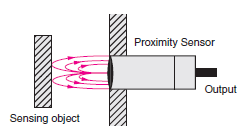Proximity Sensors
|
|
|
|
|
|
|
|
|
| Explanation of Terms | Troubleshooting |
A sensing object that serves as a reference for measuring basic performance, and that is made of specified materials and has a specified shape and dimensions.

The distance from the reference position (reference surface) to the measured operation (reset) when the standard sensing object is moved by the specified method.
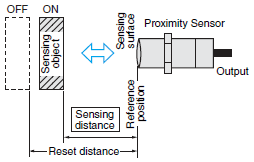
Set Distance
The distance from the reference surface that allows stable use, including the effects of temperature and voltage, to the (standard) sensing object transit position. This is approximately 70% to 80% of the normal (rated) sensing distance.
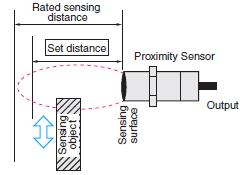
Hysteresis (Differential Travel)
With respect to the distance between the standard sensing object and the Sensor, the difference between the distance at which the Sensor operates and the distance at which the Sensor resets.
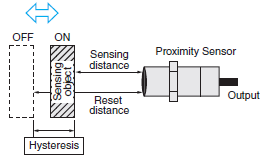
Response Time
t1: The interval from the point when the standard sensing object moves into the sensing area and the Sensor activates, to the point when the output turns ON.
t2: The interval from the point when the standard sensing object moves out of the Sensor sensing area to the point when the Sensor output turns OFF.
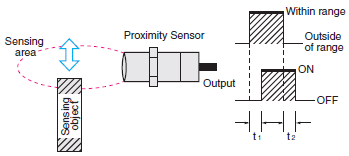
Response Frequency
The number of detection repetitions that can be output per second when the standard sensing object is repeatedly brought into proximity.
See the accompanying diagram for the measuring method.

With an Unshielded Sensor, magnetic flux is spread widely in front of the Sensor and the sides of the Sensor coil are not covered with metal.
This model is easily affected by surrounding metal objects (magnetic objects), so care must be taken in selecting the mounting location.

| Expressing the sensing distance When measuring the sensing distance of a Proximity Sensor, the reference position and the direction of approach of the sensing object are determined as follows: | |
| Cylindrical/Rectangular Sensors | |
| Perpendicular sensing distance | Horizontal sensing distance and sensing area diagram |
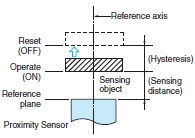 |  |
| Expressed as the measured distance from the reference surface when the standard sensing object approaches from the radial direction (perpendicular to the sensing surface). | Expressed as the measured distance from the reference axis when the standard sensing object is moved parallel to the reference surface (sensing surface). This distance depends on the transit position (distance from the reference surface), so it can be expressed as an operating point track. (Sensing Area Diagram) |
Output configuration NPN transistor output PNP transistor output Non-polarity/non-contact output 


A general-use transistor can be directly connected to a Programmable Controller or Counter. Primarily built into machines exported to Europe and other overseas destinations. A 2-wire AC output that can be used for both AC and DC Sensors. Eliminates the need to be concerned about reversing the polarity.
Take the following points into account when selecting a DC 2-wire model (polarity/no-polarity). (For details, refer to the Precautions for Correct Use in the Safety Precautions for All Proximity Sensors.)
Leakage current:
A maximum current of 0.8 mA flows to the load current even when the output is OFF. Check that the load will not operate with this current.
Output residual voltage:
When the output is ON, voltage remains in the Sensor, and the voltage applied to the load decreases.
Check that the load will operate with this load voltage.
| Output configuration | ||
| NO (normally open) | NC (normally closed) | NO/NC switchable |
 |  |  |
| When there is an object in the sensing area, the output switching element is turned ON. | When there is no object in the sensing area, the output switching element is turned ON. | NO or NC operation can be selected for the output switching element by a switch or othermeans. |



